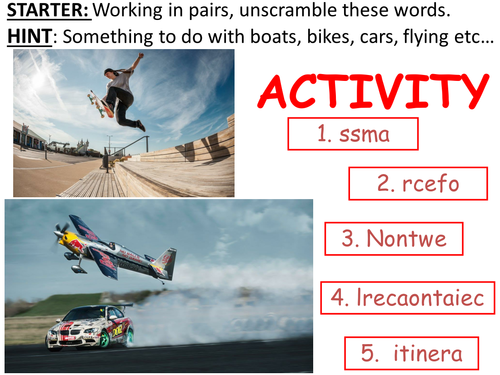


KS4 F=Ma, Newton’s 2nd Law.
There is nothing for you to do but give it a quick look through and familiarise yourself with it.
Lesson objectives:
* I can draw “free body diagrams”
* I can calculate the resultant force on an object.
* I can rearrange and use F = M a
* I can explain why an object travelling around a corner at constant speed is accelerating.
* Understand what inertia is
This carefully crafted lesson is over 40 slides long, and is full of learning activities as below:
* Notes to help the teacher.
* Starter - unscramble the words.
* Starter - simple task where students self-assess against the objectives.
* Activity sheet - differentiated and unique, all answers are provided.
* Gap fill activity - all answers are provided.
* Questions – all answers are provided.
* Differentiated questions – all answers are provided.
* Peer marking
* Theory slides (carefully sculpted, interspaced with learning activities, not ‘death by powerpoint’).
* Play ball.
* Video clip link (carefully selected – this alone can save you 20+ minutes of searching).
* Paired work activities – all answers are provided.
* Scientific Literacy activity.
* Scientific Numeracy via the many questions.
* Student self-assessment versus objectives activity – so learners can judge for themselves how much they have learnt.
As teachers we all work ridiculously long hours each week. Give yourself a break, spend some life with your wife / husband / children / friends / family by purchasing more lessons created by “Barclayfox” once they appear on TES. Please note: when searching for resources please type barclayfox into the search box/engine and it will show you all our resources.
Please purchase this lesson, and leave a positive review.
This lesson is part of a series, whilst they all work very well as standalone individual lessons you may wish to buy others from the series:
0. Bundles – contain some or even all lessons (if available, not all my series are bundled)
1. Vectors and scalars.
2. Forces between objects (contact / non-contact and Newton’s 3rd law).
3. Resultant forces – part 1
4. Resultant forces – part 2
5 to 12 - please see list in this powerpoint
Thank you, and happy teaching!
Yours,
Barclayfox.
Something went wrong, please try again later.
This resource hasn't been reviewed yet
To ensure quality for our reviews, only customers who have purchased this resource can review it
Report this resourceto let us know if it violates our terms and conditions.
Our customer service team will review your report and will be in touch.
